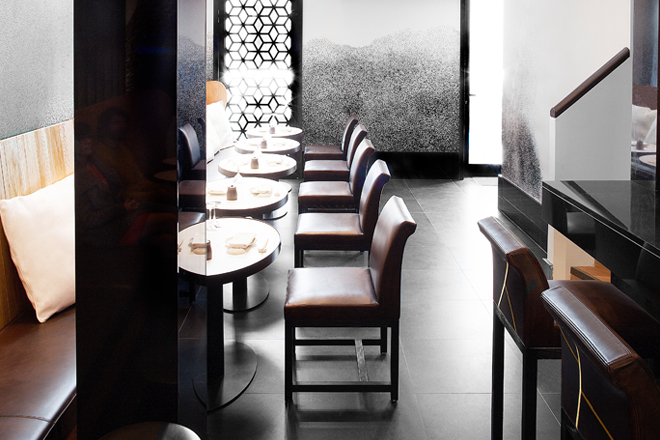A recent collaborative venture to create a unique Japanese gastonomic experience in Paris has resulted in Kinugawa. The restaurant, designed by Gilles & Boissier, abstains from typical oriental pastiche to offer a refined, artisanal and contemporary scheme, which has been created to reframe the Kinugawa heritage.
Kyoichi Kinugawa was the chef of the famous Benkay restaurant in Japan from 1978 to 1984, before going on to run his eponymous restaurant in Paris, which marked a milestone for Parisian Japanese cuisine.
Success was immediate under the leadership of Kyoichi, and the spot was soon ranked among the best Japanese restaurants in the capital, and even Europe. Kinugawa became a must-visit spot for a prestigious clientele of personalities from the worlds of fashion, film and politics, and remained so until Kyoichi’s death in 2005, which marked the end of an era.
Romain Costa, president of the Black Code Group, Parisian architects Patrick Gilles and Dorothée Boissier and master of French hospitality Laurent Hullo met in 2010 at the Hotel Orient Extrême to share and exchange ideas – and they nurtured a collaborative ambition.
As fate would have it, in early 2012, Maison Kinugawa was put up for sale – representing a unique opportunity for this colourful team to work on a joint project. Restoring Kinugawa’s acclaim, they decided to create a place dedicated to Japanese gastronomy and lifestyle that would be one of a kind in Paris.
Designer Gilles & Boissier has created a memorable interior design and decor working with a team of French artisans and artists, to distill the essence of Japanese culture in a subtle and entirely modern manner. As guests cross the threshold of the intimate double-door entrance, the visitor discovers the space that the architects have reconstructed.
A rift pierces the two floors and creates an immediate break with the outside. The 6m-high walls display a design in white plaster. The artist Alix Waline gorgeously plays with pointillism in a way that calls to mind the water movements of Japanese prints.
Entering further leads to a black granite bar and amber mirrors, facing a long bench in bronze leather, lined with tables. Here, tribute is paid to the tradition of cocktail, from the classics to special creations, taking advantage of the carefully-chosen dishes offered on the menu.
One is then seemingly projected onto a Japanese street, evoking both Tokyo and Kyoto. These two cities have inspired and made an impression on Gilles & Boissier, and here their contrasts meld beautifully. Kyoto is elegant, meditative, and sentimental while Tokyo is masculine, bold and brazen. On one side, a high pavilion. On the other, a dramatic mural.
Taking the cloistered-feeling stairway, one suddenly discovers the life and movement of the entire space via the view through wooden lace of the pavillion. The wood panelling with openwork design can be found in the windows and in the openings, acting as a screen to create the kind of shadow play and transparency that is an integral part of Japanese theatre.
The traditional large room on the first floor, with its majestic volumes, has been preserved, creating a unifying place where individuals and worlds converge, giving Kinugawa the necessary dose of soul and life to make a great space; the walls are textured like the traces of water on the sand, the seating is greige-coloured and the rugs are graphic.
The materials are raw and natural – dark cedar, light cedar, fired and polished black stone.
Upstairs is l’Atelier, an intimate room where one can watch the hypnotic beauty of the sushimen at work on the other side of the counter.
The new Kinugawa looks as though it will be able to rediscover its elan and its rightful place at the zenith of Parisian Japanese cuisine. The visionary group has indeed created a space of discovery and pleasure enhanced by a classic French savior-vivre. A true joy.



